For many dog lovers, the joy of pet ownership can often be overshadowed by the constant battle against shedding fur and the allergic reactions it can trigger. Living with dog allergies doesn’t mean you have to miss out on the companionship of a canine friend. The good news is that there are many fantastic dog breeds that don’t shed much, making them ideal choices for individuals and families seeking a cleaner home and fewer sniffles. Understanding which breeds fall into this category and why is key to finding your perfect furry match.
Understanding Low-Shedding & “Hypoallergenic” Dogs
The term “hypoallergenic” is often associated with dog breeds that shed minimally. However, it’s crucial to understand that no dog is truly 100% allergen-free. All dogs produce allergens, primarily found in their dander (flakes of dead skin), saliva, and urine. These allergens are what trigger allergic reactions, not necessarily the hair itself.
Dog breeds that don’t shed much are often referred to as “hypoallergenic” because they release less dander into the environment. When a dog sheds less, fewer dead skin cells (dander) and less fur carrying saliva proteins are dispersed around your home, thereby reducing the amount of allergens present. This can significantly alleviate allergy symptoms such as sneezing, itching, coughing, or wheezing for sensitive individuals. For those exploring their options, a comprehensive look at breeds of dogs that don t shed much can provide valuable insights. It’s important to remember that individual reactions can vary, so spending time with a specific breed before committing is always recommended.
Benefits of Choosing a Dog Breed That Doesn’t Shed Much
Opting for a dog breed that doesn’t shed much offers numerous advantages beyond just allergy management. These breeds typically lead to a noticeably cleaner home environment. You’ll find less dog hair on your furniture, clothes, and floors, reducing the need for constant vacuuming and dusting. This not only saves time but also creates a more pleasant living space for everyone.
Furthermore, many low-shedding breeds are known for their distinct coat types, such as curly, wiry, or silky textures. While they shed less, these coats often require regular grooming, which can be a wonderful bonding experience for pet parents and their pups. Consistent grooming helps remove loose hairs and dander before they become airborne, further managing potential allergens. This routine also keeps their coats healthy, preventing mats and skin issues. For instance, those interested in smaller companions might find our guide on small dog breeds that dont shed much particularly useful. Ultimately, choosing a dog with minimal shedding can lead to a more comfortable, cleaner, and healthier co-existence for both dog and owner.
Top Dog Breeds That Don’t Shed Much
When searching for a canine companion that won’t leave a trail of fur behind, there’s a surprisingly diverse selection of dog breeds that don’t shed much. From tiny lapdogs to energetic large breeds, there’s a low-shedding pup to suit almost any lifestyle. While their shedding is minimal, it’s worth noting that many of these breeds still require regular grooming to keep their coats healthy and tangle-free. This list highlights 30 excellent choices, each with unique characteristics and charm.
1. Poodle
 White Poodle with a well-groomed coat walking gracefully through lush green grass on a sunny day.
White Poodle with a well-groomed coat walking gracefully through lush green grass on a sunny day.
Poodles are perhaps the most famous of the low-shedding breeds. Available in Standard, Miniature, and Toy sizes, they are renowned for their intelligence and highly trainable nature. Their dense, curly coat sheds minimally but requires consistent brushing and professional grooming to prevent matting and maintain its distinctive appearance. Poodles are active and enjoy mental stimulation, making them versatile companions for various families.
2. Yorkshire Terrier
 A small, elegant blue and tan Yorkshire Terrier lounging comfortably on a patterned armchair, looking alert and poised.
A small, elegant blue and tan Yorkshire Terrier lounging comfortably on a patterned armchair, looking alert and poised.
These tiny dogs pack a lot of personality into their small frames. Yorkshire Terriers, or Yorkies, possess a single, silky coat that is more like human hair and sheds very little. They are affectionate and spirited, adapting well to different living situations, from bustling city apartments to larger homes, provided they receive ample attention and companionship. Regular brushing is essential to keep their long coats free of tangles.
3. Shih Tzu
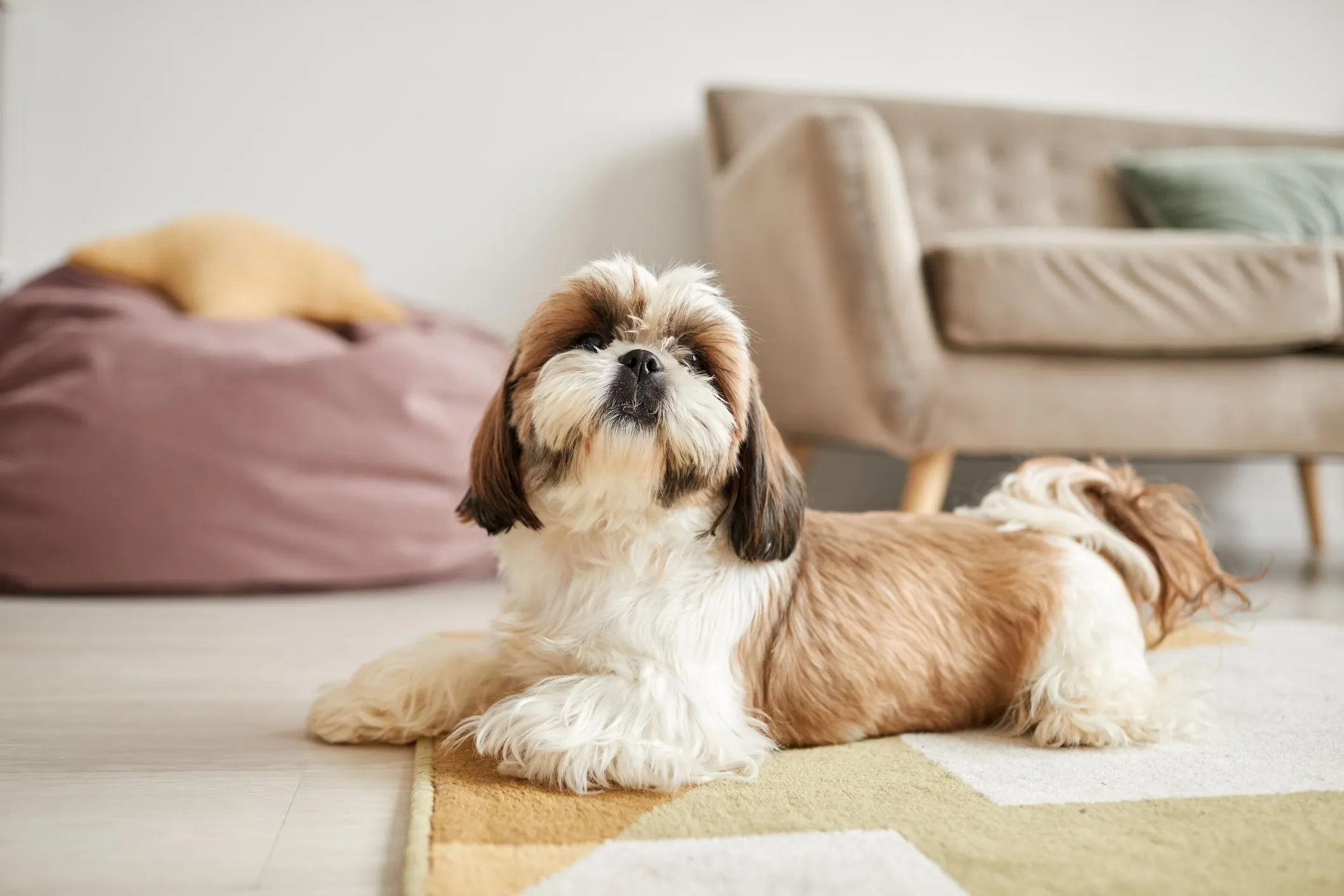 A fluffy brown and white Shih Tzu with a distinctive long coat peacefully lying on a light-colored living room floor.
A fluffy brown and white Shih Tzu with a distinctive long coat peacefully lying on a light-colored living room floor.
An ancient companion breed, the Shih Tzu is celebrated for its friendly and outgoing temperament. Their flowing double coat sheds very little but demands daily grooming to avoid mats and keep them comfortable. Owners should be aware of their brachycephalic (flat-faced) characteristics, which can predispose them to health issues like overheating and breathing difficulties. Regular eye cleaning can also help manage tear stains common in the breed.
4. Miniature Schnauzer
 A salt and pepper Miniature Schnauzer wearing a pink harness, standing attentively in a sunlit park with green foliage.
A salt and pepper Miniature Schnauzer wearing a pink harness, standing attentively in a sunlit park with green foliage.
The smallest of the Schnauzer family, Miniature Schnauzers are robust and intelligent dogs. Their wiry topcoat and soft undercoat shed minimally. Weighing between 10-20 pounds and standing up to 14 inches tall, they are adaptable to various living spaces. These energetic dogs thrive on at least an hour of exercise daily, combined with regular grooming, including hand-stripping or clipping, to maintain their iconic look.
5. Standard Schnauzer
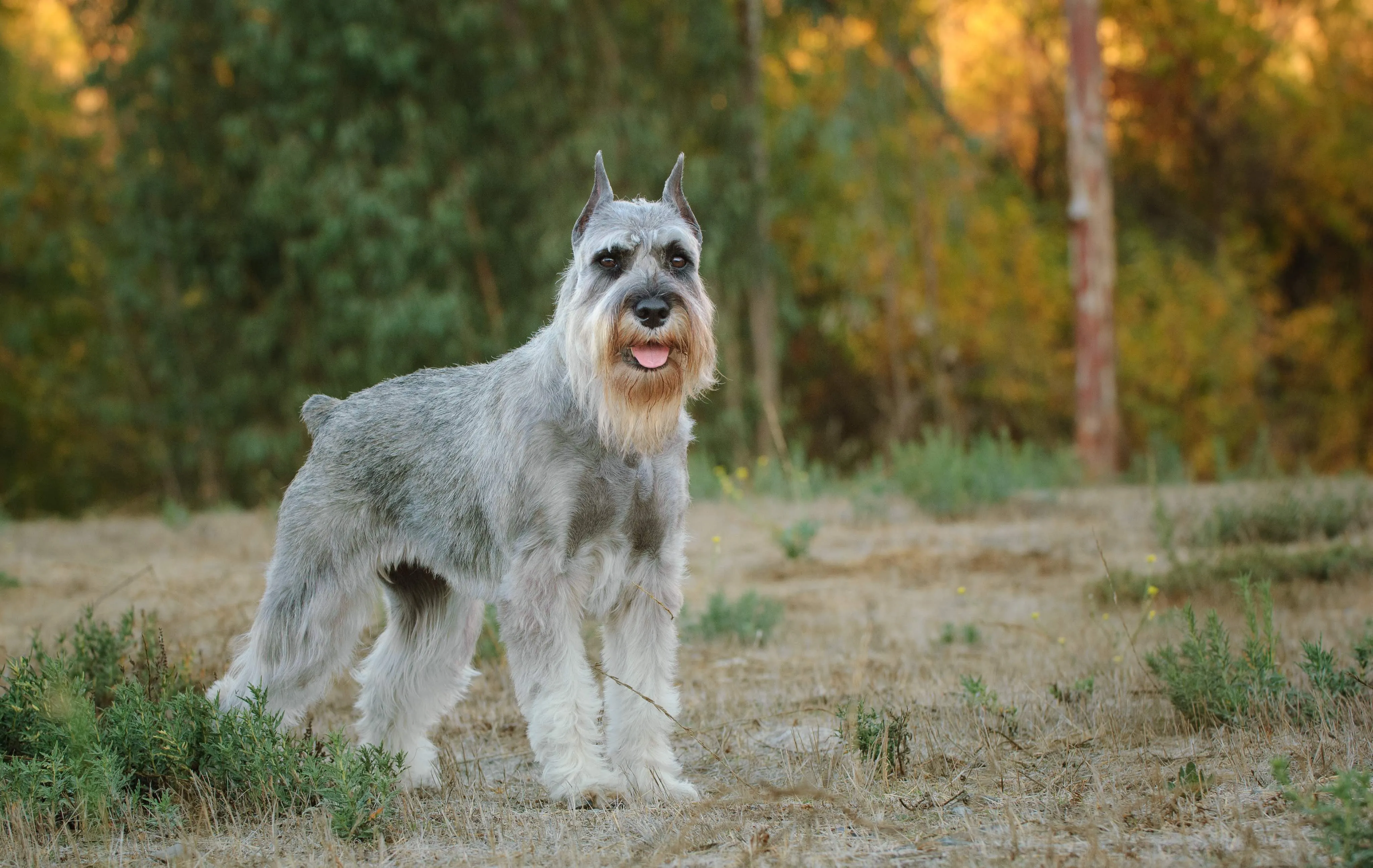 A distinguished gray Standard Schnauzer with its signature wiry coat standing confidently in a grassy field.
A distinguished gray Standard Schnauzer with its signature wiry coat standing confidently in a grassy field.
The Standard Schnauzer shares the desirable low-shedding coat and intelligent nature of its miniature counterpart but in a more substantial package, typically weighing up to 45 pounds. They are lively and enjoy engaging in activities like long walks, games of fetch, and interactive puzzle toys. Their strong build and alert demeanor make them excellent family protectors, requiring consistent exercise and mental engagement.
6. Giant Schnauzer
 A large, imposing black Giant Schnauzer with a wet, curly coat, wearing a blue bow collar, standing alert in a park.
A large, imposing black Giant Schnauzer with a wet, curly coat, wearing a blue bow collar, standing alert in a park.
As their name suggests, Giant Schnauzers are among the largest dog breeds that don’t shed much, capable of reaching over 27 inches in height and weighing up to 85 pounds. These powerful and intelligent dogs demand significant exercise, including long walks, runs, and hikes, to stay content and well-behaved. Their thick, wiry coat requires diligent grooming to prevent matting and maintain its condition. When considering large dog breeds that don t shed much, the Giant Schnauzer is a prime example of a sturdy, low-shedding companion.
7. Bichon Frise
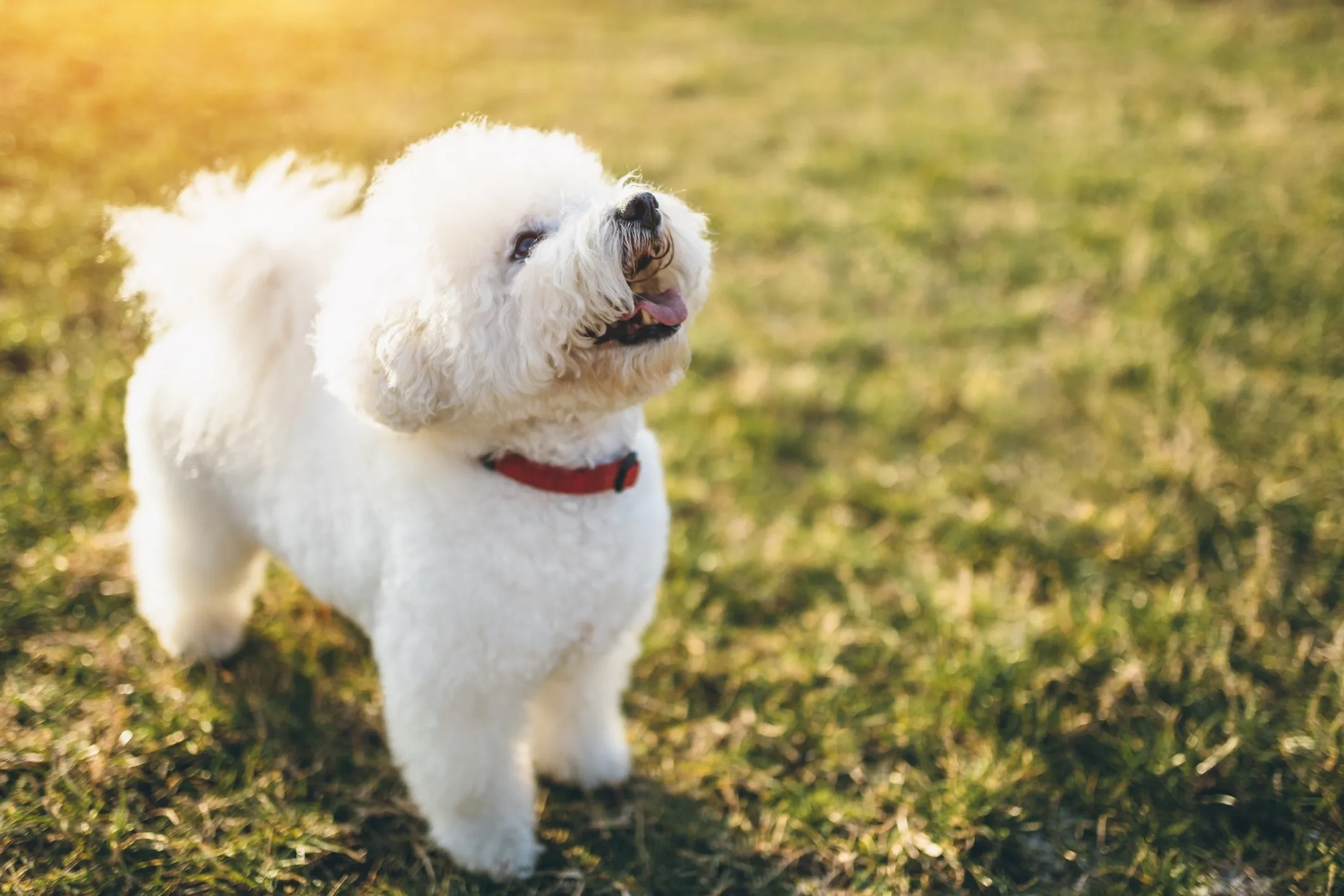 A fluffy white Bichon Frise dog with a curly coat, looking upwards intently while sitting in bright green grass.
A fluffy white Bichon Frise dog with a curly coat, looking upwards intently while sitting in bright green grass.
The Bichon Frise is a cheerful, playful, and affectionate small dog with a distinct curly, powder-puff coat that sheds very little. Their high intelligence and eagerness to please make them highly trainable, excelling in basic obedience and learning fun tricks. Bichons thrive on companionship and regular grooming to prevent their soft coats from matting.
8. Chinese Crested
 A striking black hairless Chinese Crested dog looking directly at the camera, showcasing its smooth skin and tufts of hair.
A striking black hairless Chinese Crested dog looking directly at the camera, showcasing its smooth skin and tufts of hair.
Known for their unique appearance, the Chinese Crested comes in two varieties: hairless and powderpuff. Both varieties are considered low-shedding. The hairless version has smooth skin with tufts of hair on its head, tail, and paws, while the powderpuff has a full, soft coat. They are playful, affectionate, and make wonderful, devoted companions, though the hairless variety requires skin protection from sun and cold.
9. Portuguese Water Dog
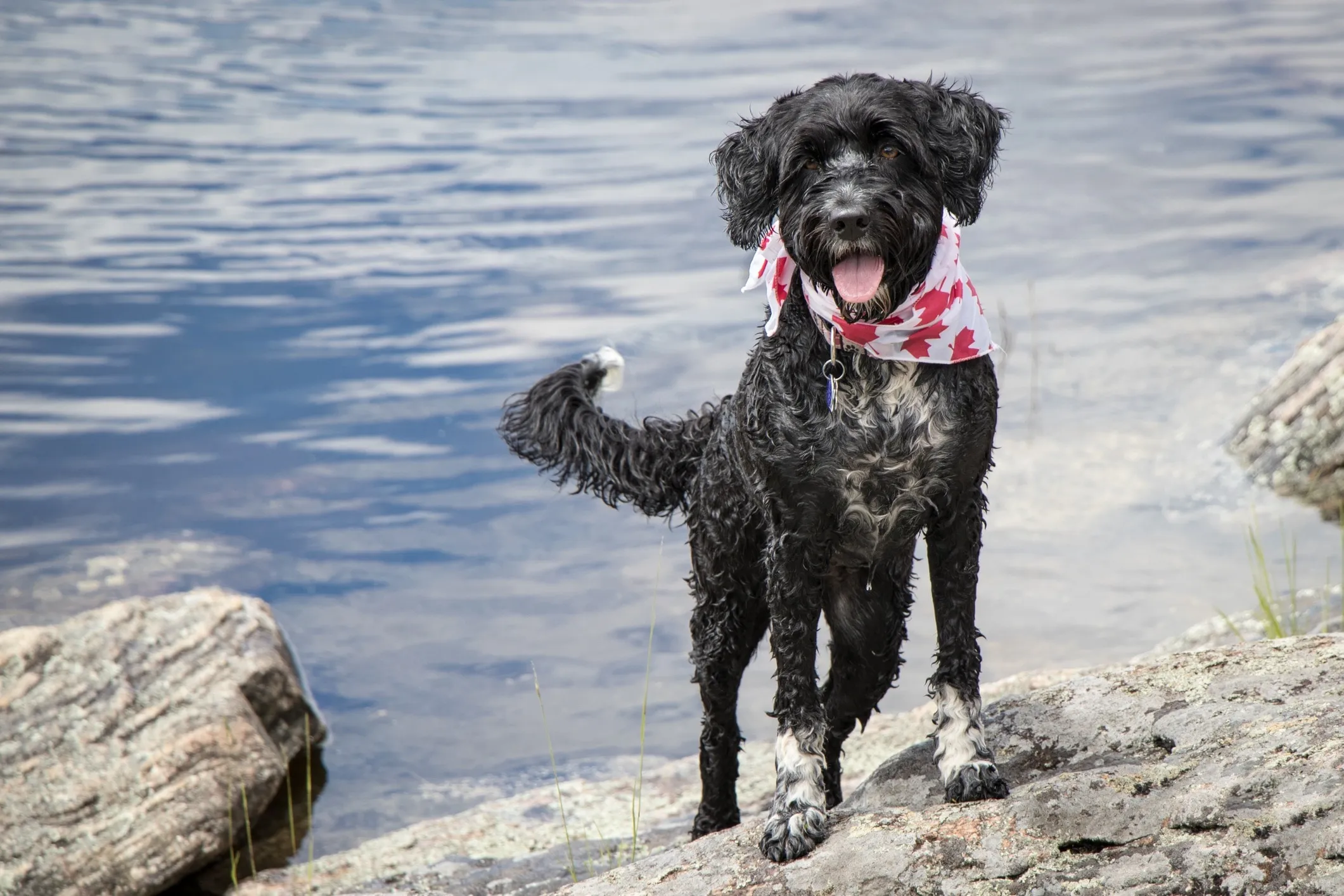 A black and white Portuguese Water Dog wearing a red maple leaf bandana, sitting composedly by the water's edge.
A black and white Portuguese Water Dog wearing a red maple leaf bandana, sitting composedly by the water's edge.
Originally bred to assist fishermen, the Portuguese Water Dog is a medium-sized, athletic breed known for its thick, curly coat that sheds minimally. They are intelligent, highly trainable, and friendly, making them excellent family pets. These high-energy dogs require consistent exercise, often enjoying water activities like swimming, to keep them happy and healthy.
10. Labradoodle
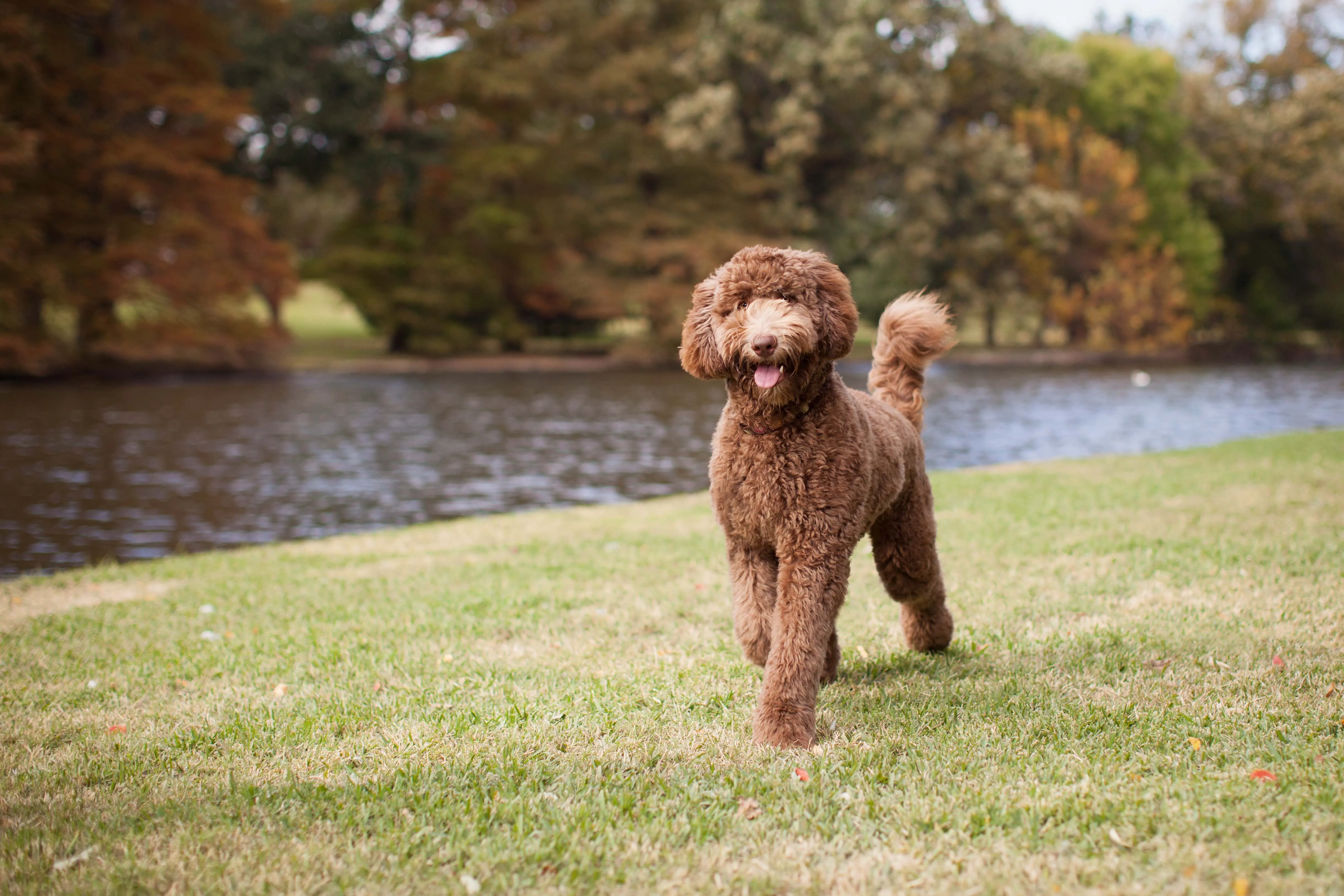 A brown Standard Labradoodle with a shaggy, curly coat walking through a vibrant green park on a sunny day.
A brown Standard Labradoodle with a shaggy, curly coat walking through a vibrant green park on a sunny day.
A popular crossbreed between a Labrador Retriever and a Poodle, the Labradoodle was initially developed as a low-shedding service dog. They inherit intelligence and a friendly disposition from both parents, making them excellent family pets. Labradoodles are highly trainable and gentle, especially when well-socialized and adequately exercised. Their wavy to curly coats require regular grooming.
11. Goldendoodle
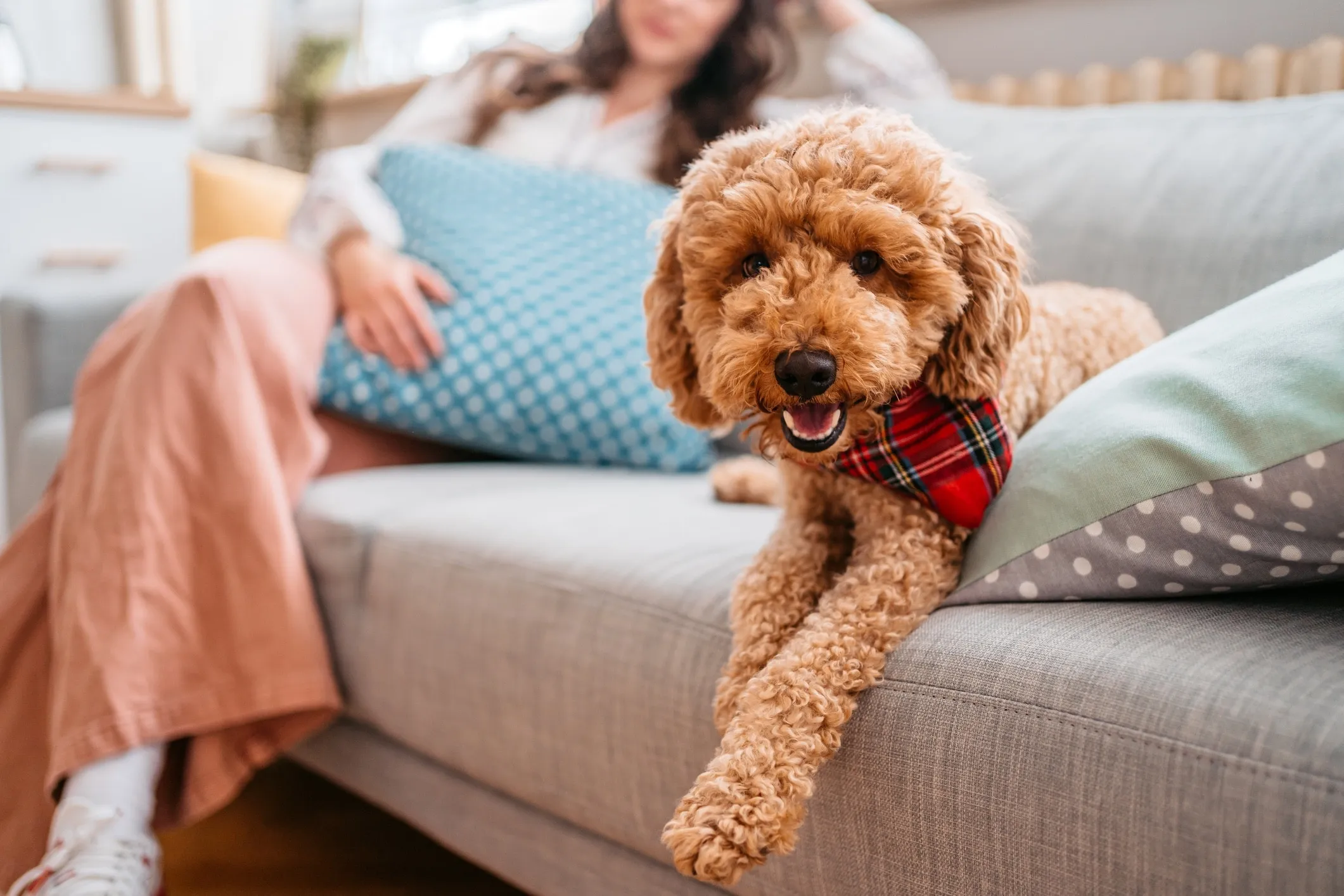 A fluffy Goldendoodle lying comfortably on a plush couch, with a person sitting in the background, creating a cozy domestic scene.
A fluffy Goldendoodle lying comfortably on a plush couch, with a person sitting in the background, creating a cozy domestic scene.
Another beloved “doodle” breed, Goldendoodles are a cross between a Golden Retriever and a Poodle. Like Labradoodles, they are cherished for their friendly nature, high intelligence, and low-shedding coats. They come in various colors and coat textures, from wavy to curly, all requiring frequent grooming with a slicker brush to prevent matting. They are known for being gentle and great with families.
12. Lagotto Romagnolo
 Two curly-coated Lagotto Romagnolo dogs lying in sandy dirt, looking intently towards the camera.
Two curly-coated Lagotto Romagnolo dogs lying in sandy dirt, looking intently towards the camera.
Lagotto Romagnolo dogs, historically bred as water retrievers in Italy, possess a thick, woolly, curly coat that offers protection in chilly waters and sheds very little. Though less common, they are excellent family dogs, typically good with children and other pets. Their playful and affectionate nature, combined with their moderate exercise needs, makes them charming companions.
13. Affenpinscher
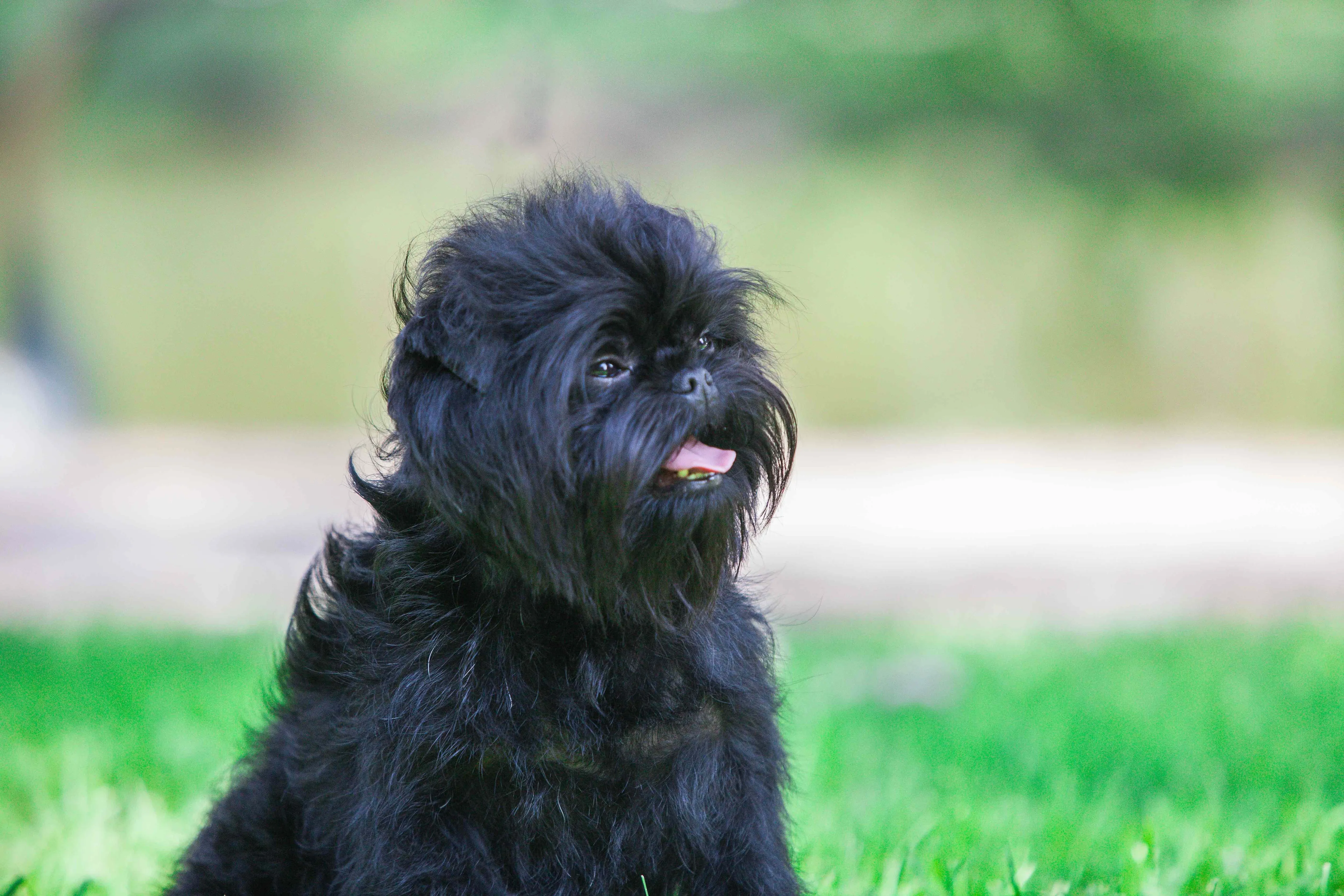 A close-up of a black Affenpinscher dog's expressive, monkey-like face with its characteristic dense, wiry coat.
A close-up of a black Affenpinscher dog's expressive, monkey-like face with its characteristic dense, wiry coat.
Affenpinschers are small dogs recognized for their distinctive monkey-like expressions. Their dense, wiry coat sheds minimally compared to many other breeds. However, this unique coat requires dedicated care, including regular at-home brushing and specialized grooming techniques like hand-stripping, where dead hair is removed from the root to maintain texture and health.
14. Irish Water Spaniel
 A profile view of a majestic brown Irish Water Spaniel with its characteristic curly coat and rat tail.
A profile view of a majestic brown Irish Water Spaniel with its characteristic curly coat and rat tail.
Friendly, highly intelligent, and easily trainable, the Irish Water Spaniel is another water-loving breed with a low-shedding, thick, curly coat that is always liver (brown) in color. Originally bred for retrieving game, these dogs have high energy levels and require consistent exercise to stay happy and healthy. Regular grooming is essential to keep their unique coat in top condition.
15. Aussiedoodle
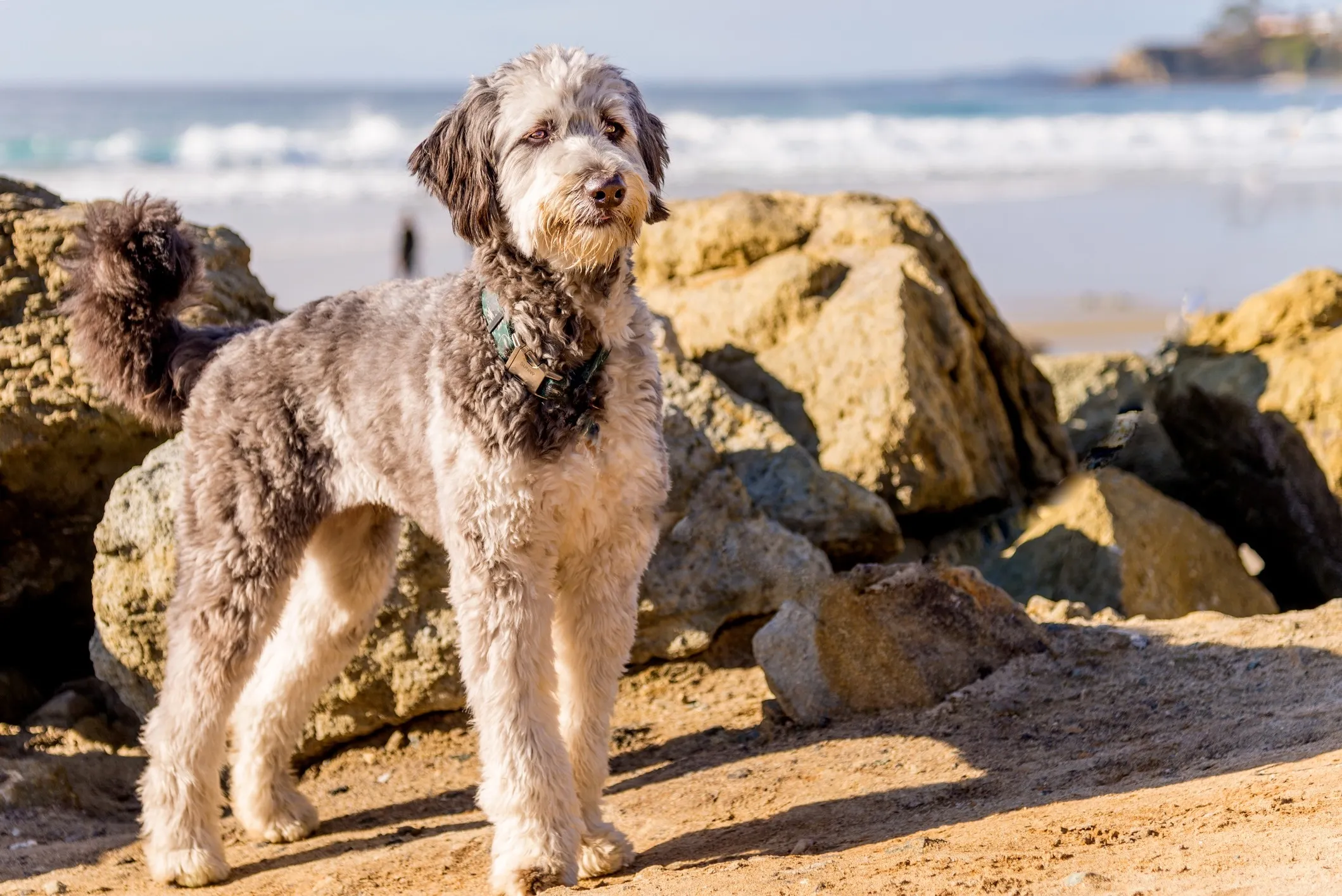 A standard Aussiedoodle dog standing gracefully on a sandy beach, enjoying the coastal view.
A standard Aussiedoodle dog standing gracefully on a sandy beach, enjoying the coastal view.
The Aussiedoodle is a cross between an Australian Shepherd and a Poodle (Standard or Miniature). This intelligent and highly energetic breed inherits its low-shedding qualities and zest for life from both parents. Aussiedoodles thrive on plenty of exercise and mental stimulation through enrichment toys to prevent boredom and destructive behaviors. Their wavy to curly coats require regular brushing.
16. Bolognese
 A fluffy white Bolognese dog sitting attentively in an autumn forest, surrounded by fallen leaves and soft light.
A fluffy white Bolognese dog sitting attentively in an autumn forest, surrounded by fallen leaves and soft light.
Hailing from Italy, the Bolognese is a charming, playful, and easygoing small dog with a long, fluffy white coat that sheds little. Despite their characteristic “messy” appearance, their coat needs diligent grooming to prevent matting. Known for getting along well with children and other pets, Bolognese adapt comfortably to various living situations, making them delightful family additions.
17. Maltese
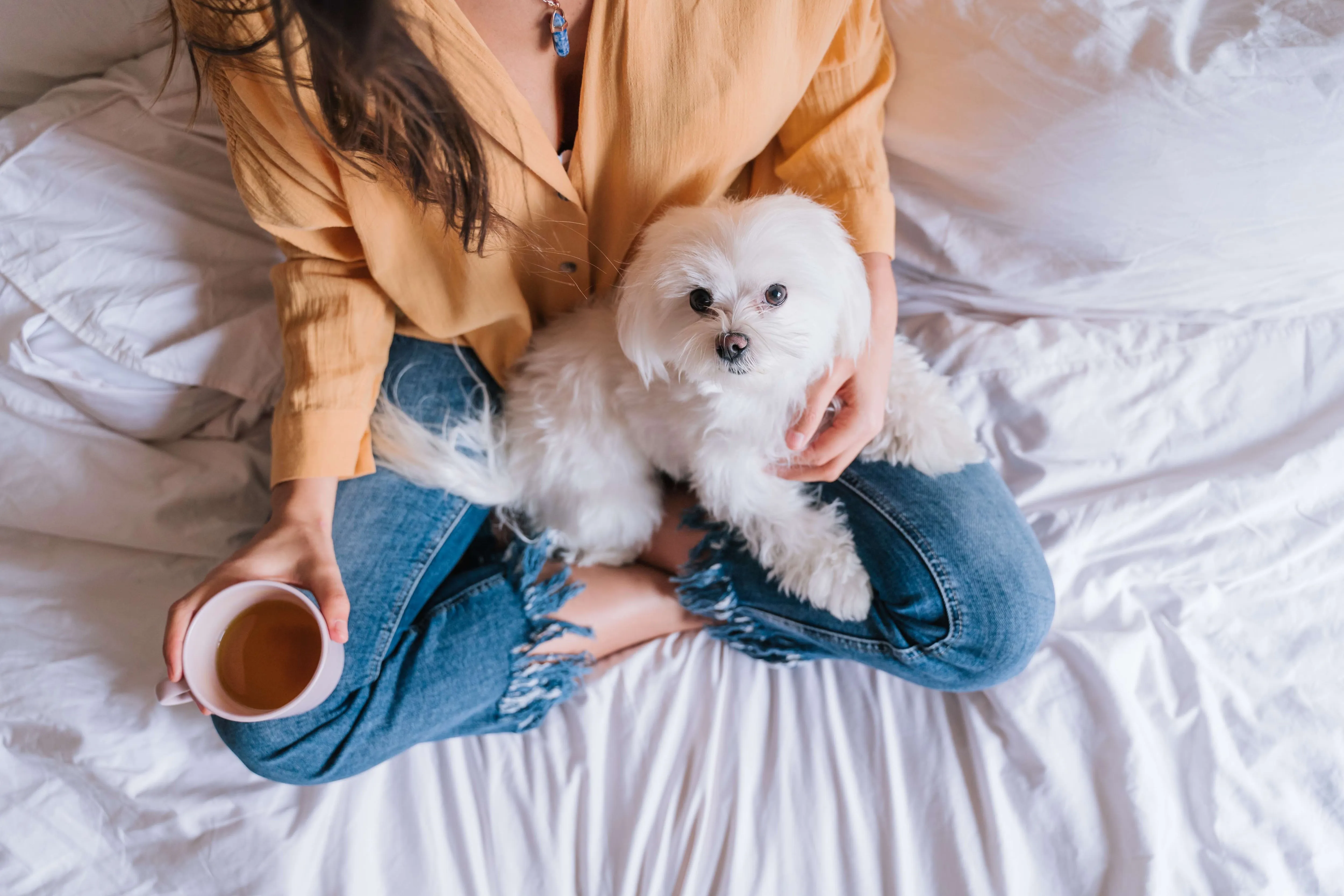 A woman gently holding a pristine white Maltese dog, featuring its long, luxurious coat, while on a bed.
A woman gently holding a pristine white Maltese dog, featuring its long, luxurious coat, while on a bed.
The Maltese is a small, affectionate, and playful companion celebrated for its luxurious, silky white coat that sheds minimally. While their elegant long hair requires significant grooming, many owners opt for a shorter “puppy cut” to simplify maintenance. Maltese dogs thrive on close companionship and make wonderful lap dogs, always ready for a cuddle or a game.
18. Soft Coated Wheaten Terrier
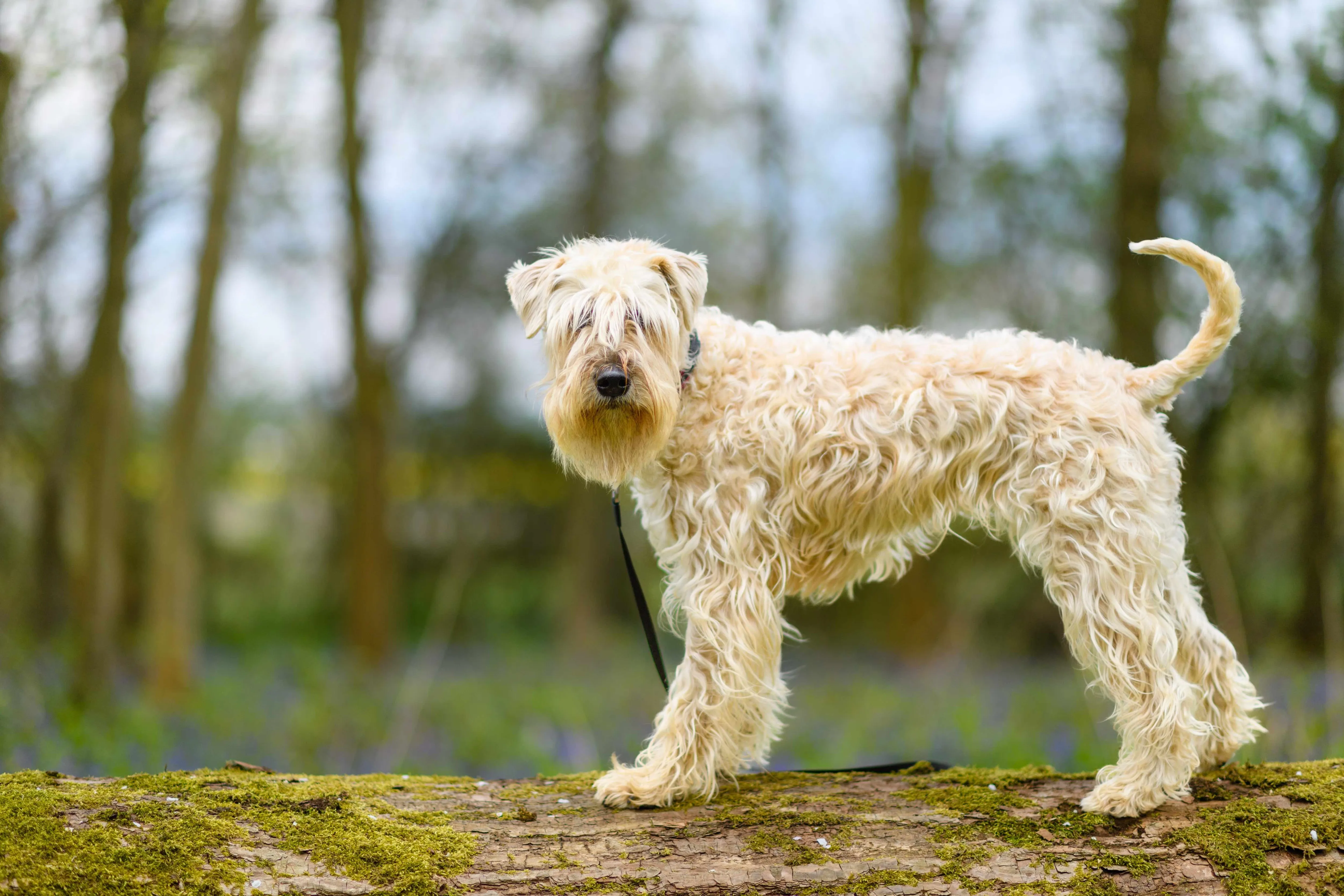 A Soft Coated Wheaten Terrier dog with its characteristic silky, wheat-colored coat sitting on a log in a natural setting.
A Soft Coated Wheaten Terrier dog with its characteristic silky, wheat-colored coat sitting on a log in a natural setting.
This medium-sized Irish breed is named for its incredibly soft, silky coat that sheds sparingly. Soft Coated Wheaten Terriers maintain a high energy level throughout their lives, requiring ample exercise and mental stimulation to keep them engaged and well-behaved. Their charming and often boisterous personalities make them joyful family members. Regular brushing prevents their soft coat from matting.
19. Coton de Tulear
 A beautiful white Coton de Tulear with its fluffy coat gently blowing in the wind, sitting gracefully in lush green grass.
A beautiful white Coton de Tulear with its fluffy coat gently blowing in the wind, sitting gracefully in lush green grass.
Originating from Madagascar, the Coton de Tulear is a small, easygoing, and charming breed with a soft, cotton-like coat that sheds minimally. Their good-natured temperament makes them excellent companions for families with children and other pets, especially with proper introductions. Cotons are adaptable and thrive on companionship, enjoying both quiet cuddles and playful activities.
20. Schnoodle
 A close-up portrait of a gray Schnoodle dog with its characteristic curly, low-shedding coat and intelligent eyes.
A close-up portrait of a gray Schnoodle dog with its characteristic curly, low-shedding coat and intelligent eyes.
The Schnoodle is a delightful crossbreed combining two low-shedding breeds: the Schnauzer and the Poodle. Their coat can range from wavy to tightly curled, depending on their genetic inheritance, but it is consistently low-shedding. Schnoodles are intelligent, playful, and affectionate, making them wonderful family pets that often inherit the best traits from both parent breeds.
21. Bedlington Terrier
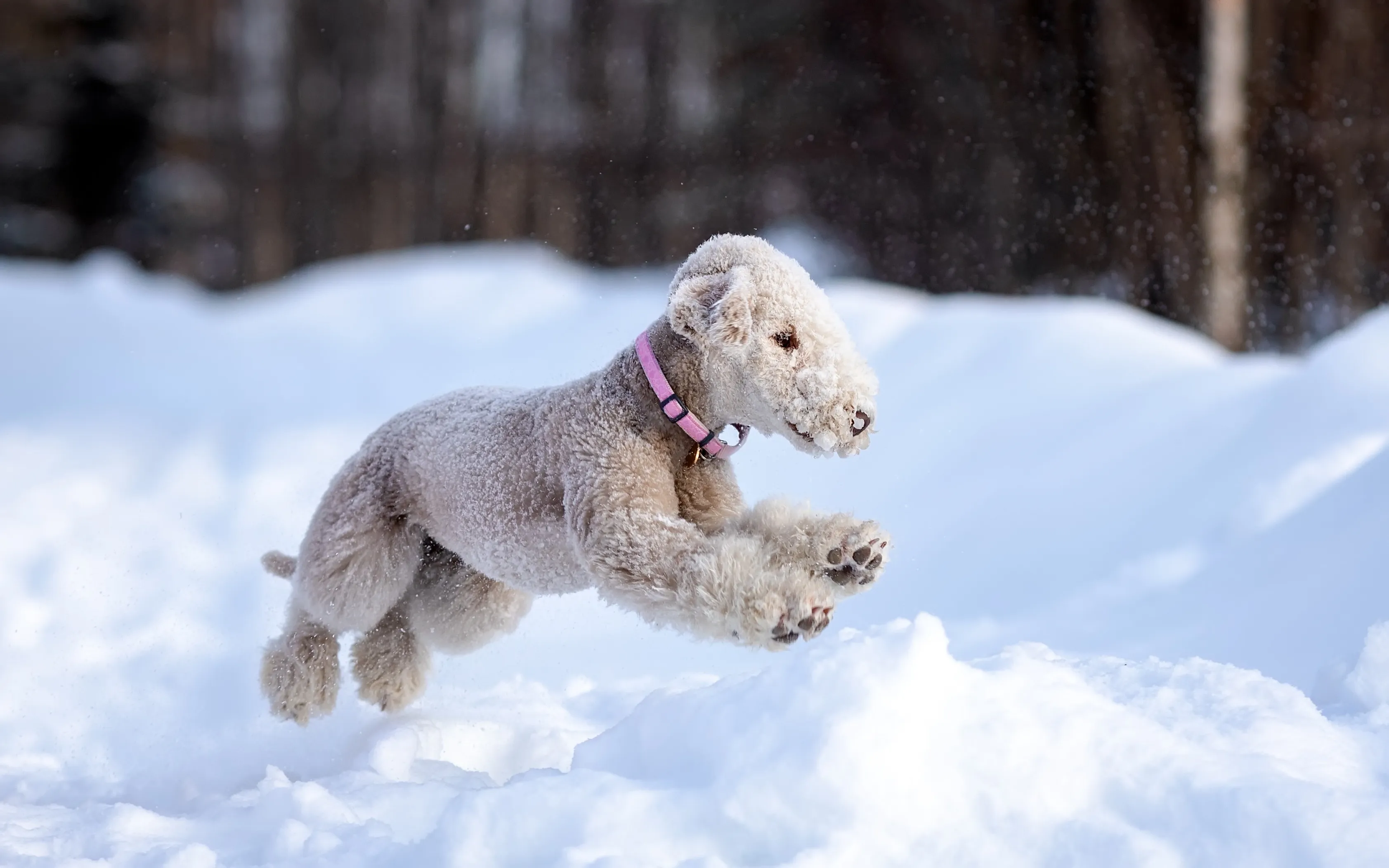 A white Bedlington Terrier with its distinctive lamb-like appearance running joyfully through fresh snow.
A white Bedlington Terrier with its distinctive lamb-like appearance running joyfully through fresh snow.
Often described as “a lamb in dog’s clothing,” the Bedlington Terrier is a distinctive small, curly-haired breed known for its unique topknot and ear tufts. This devoted breed thrives on human companionship and can be prone to separation anxiety if left alone for extended periods. Their minimal shedding coat requires regular grooming, including clipping or hand-stripping, to maintain its sculpted look.
22. Xoloitzcuintli
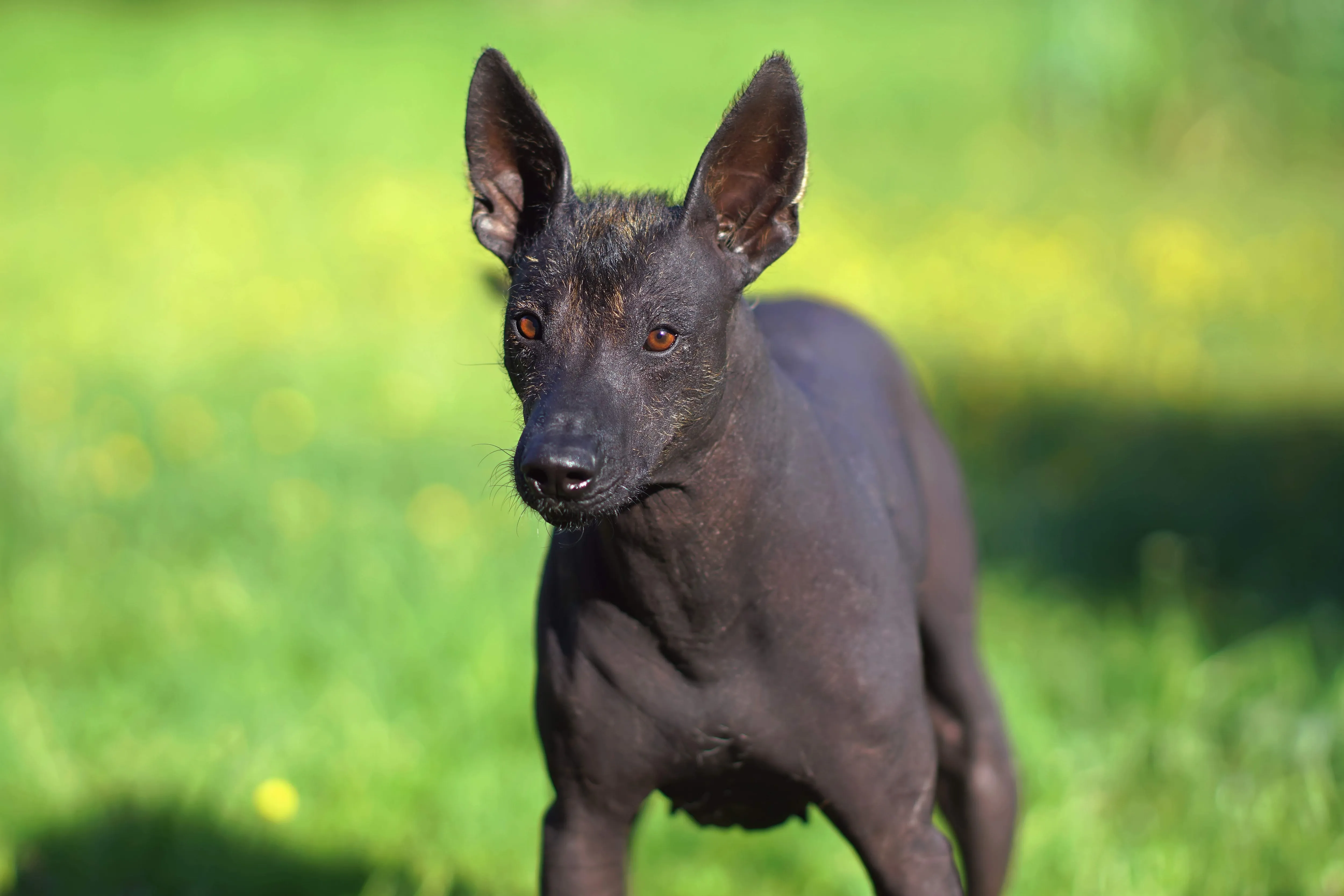 A sleek black Mexican Hairless Dog (Xoloitzcuintli) standing alertly in a field of green grass.
A sleek black Mexican Hairless Dog (Xoloitzcuintli) standing alertly in a field of green grass.
Also known as the Mexican Hairless Dog, the Xoloitzcuintli is one of the oldest and rarest dog breeds that don’t shed much. This ancient breed comes in three sizes (toy, miniature, and standard) and can be either hairless or have a very short, fine coat. Both varieties are low-shedding. Xolos are known for being calm, loyal, and protective companions, though their hairless skin requires protection from sun and cold.
23. Whoodle
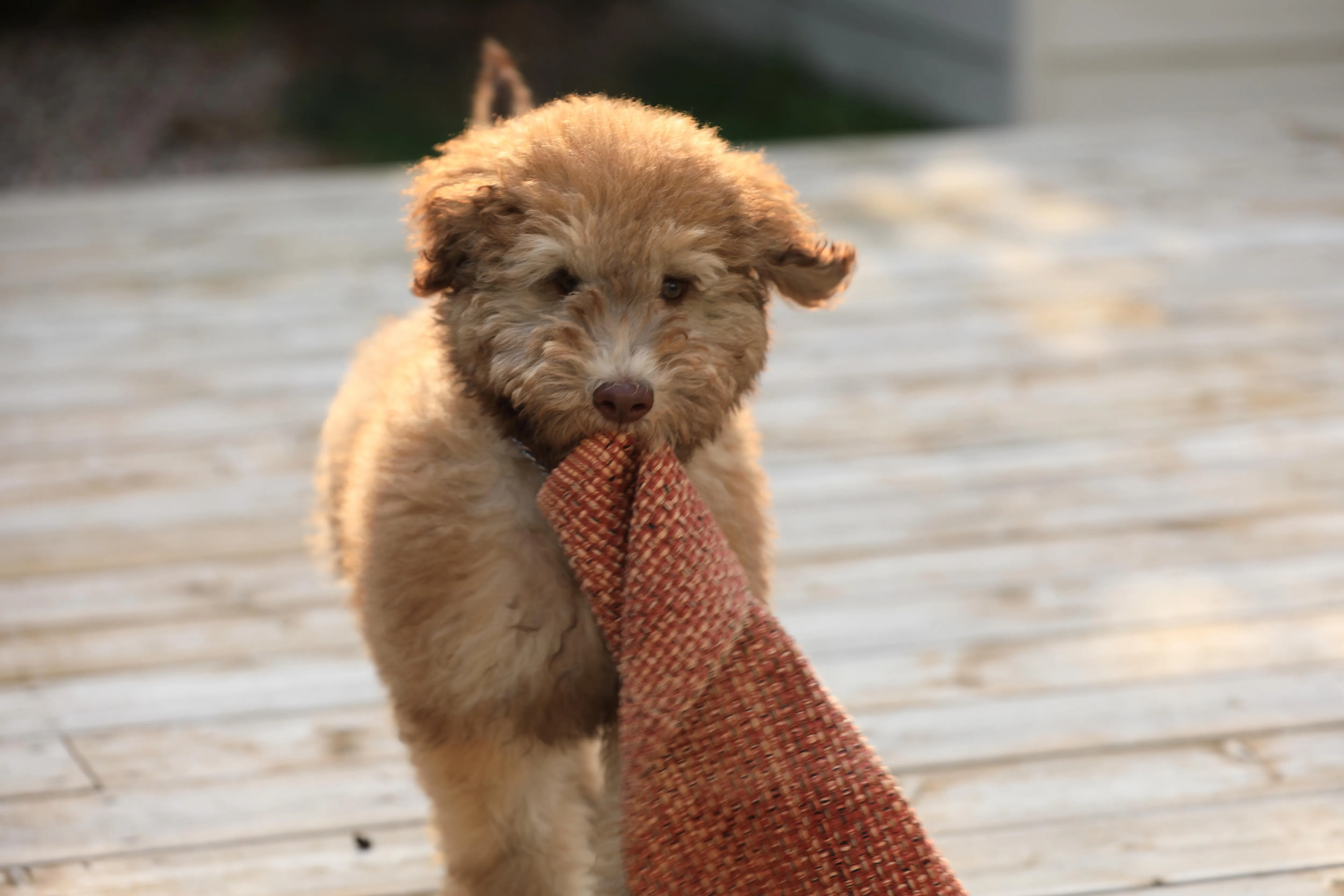 A tan Whoodle puppy with soft, wavy fur playfully dragging a white washcloth across a wooden floor.
A tan Whoodle puppy with soft, wavy fur playfully dragging a white washcloth across a wooden floor.
A charming mix of a Soft-Coated Wheaten Terrier and a Poodle, the Whoodle is a friendly dog known for its minimal shedding coat. These intelligent and affectionate dogs inherit desirable traits from both parent breeds, making them energetic yet gentle companions. Whoodles thrive on interaction and exercise, and their soft, wavy coats require regular grooming. For families seeking canine companions that shed less, this breed offers a delightful blend of personality and practicality. Further options and details can be found when exploring dog breeds that dont shed very much.
24. Bernedoodle
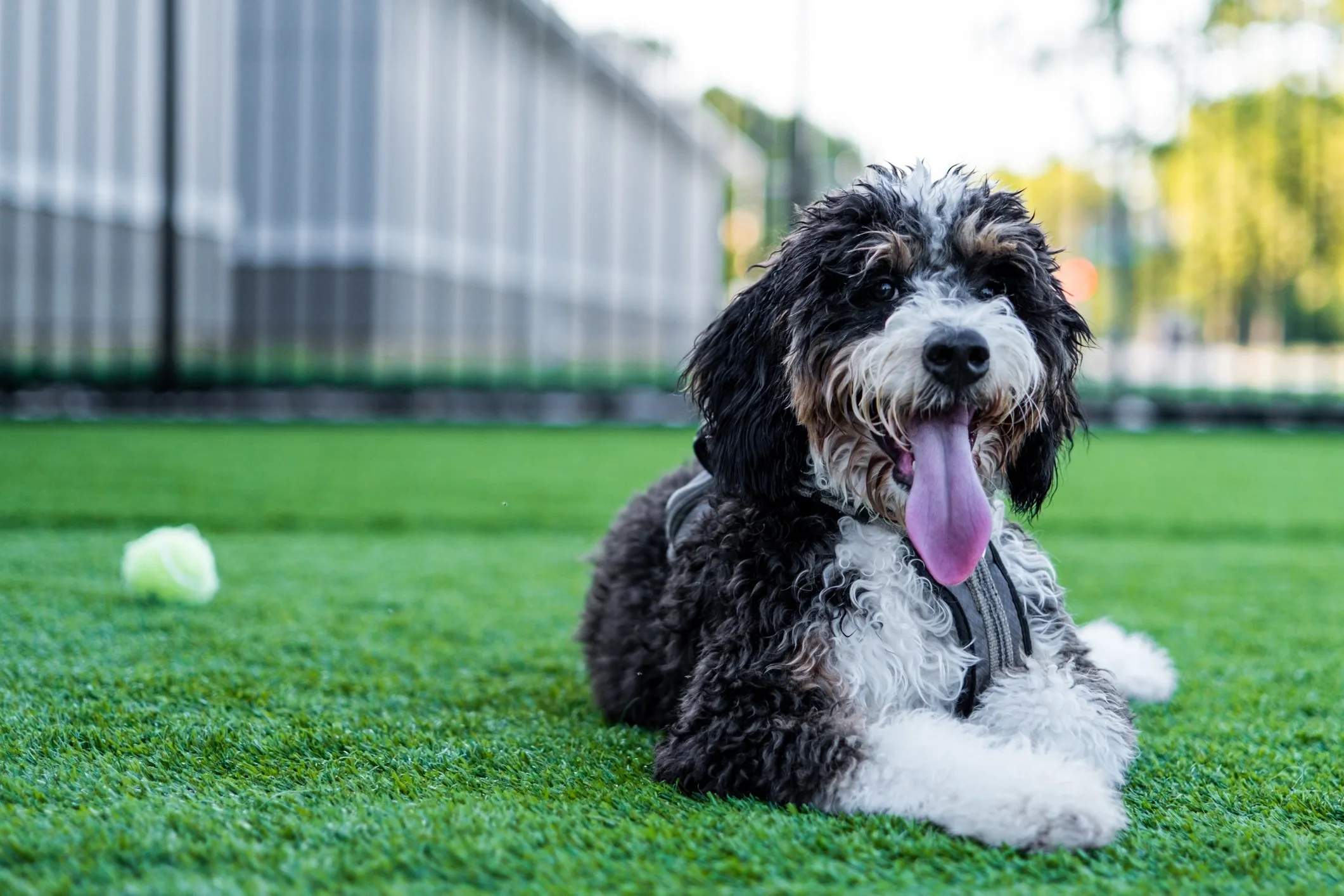 A large, fluffy Bernedoodle dog with a tri-color coat lying happily in green grass with its tongue slightly out.
A large, fluffy Bernedoodle dog with a tri-color coat lying happily in green grass with its tongue slightly out.
Bernedoodles are a crossbreed between a Bernese Mountain Dog and a Poodle, celebrated for their friendly, affectionate nature and gentle demeanor. These large, low-shedding dogs are a popular choice for families with children and other pets. They require plenty of exercise to stay active and content, and their wavy or curly coats need regular grooming to prevent matting.
25. Shorkie
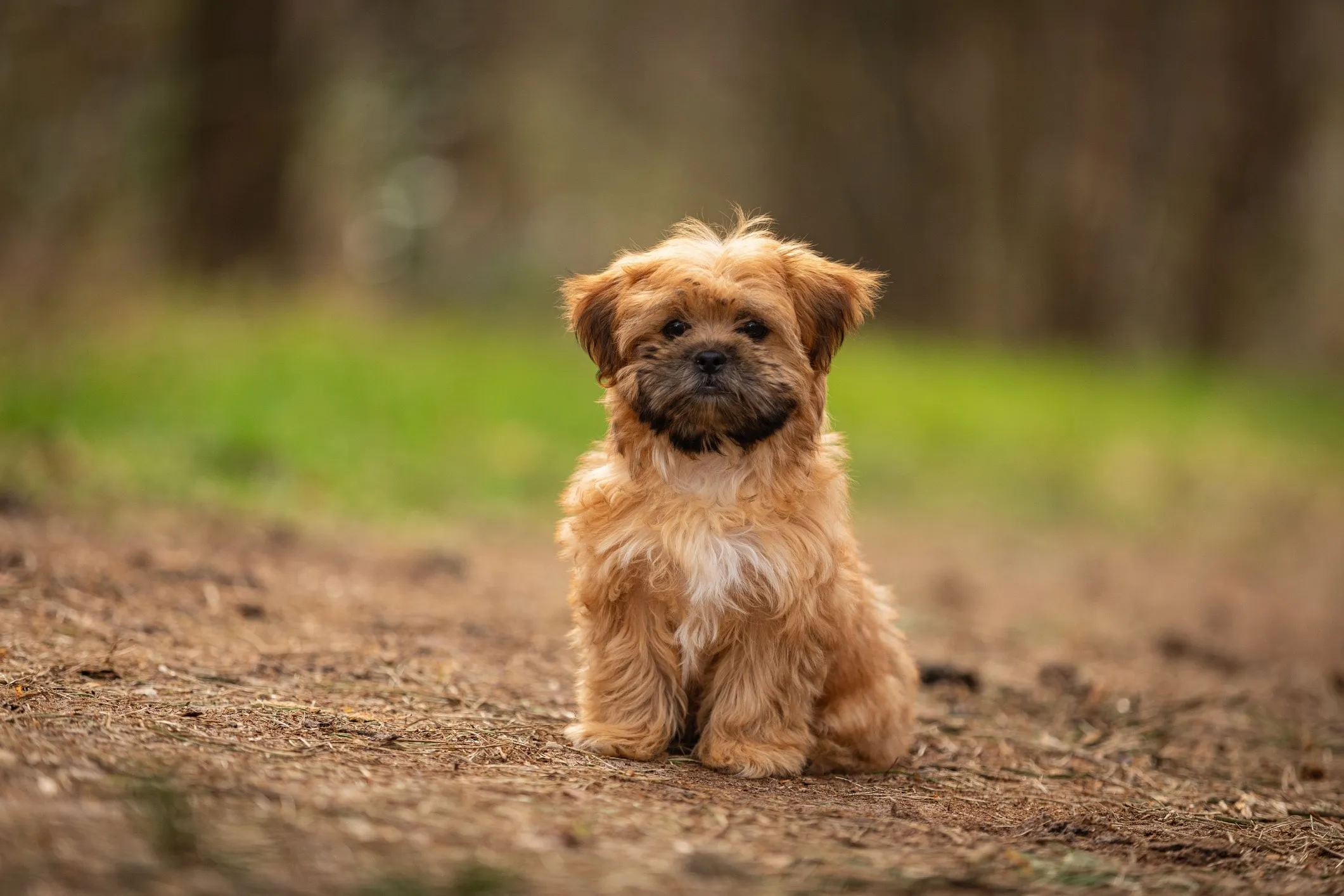 A small, adorable tan and black Shorkie mix dog sitting alertly on a hiking trail in a natural outdoor setting.
A small, adorable tan and black Shorkie mix dog sitting alertly on a hiking trail in a natural outdoor setting.
The Shorkie is a lively mixed breed created from a Shih Tzu and a Yorkshire Terrier, combining the best low-shedding qualities of both parents. These small, playful, and friendly dogs thrive on companionship. Like most breeds on this list, their silky or wavy coats require a dedicated and regular grooming routine to keep them healthy and beautiful.
26. Afghan Hound
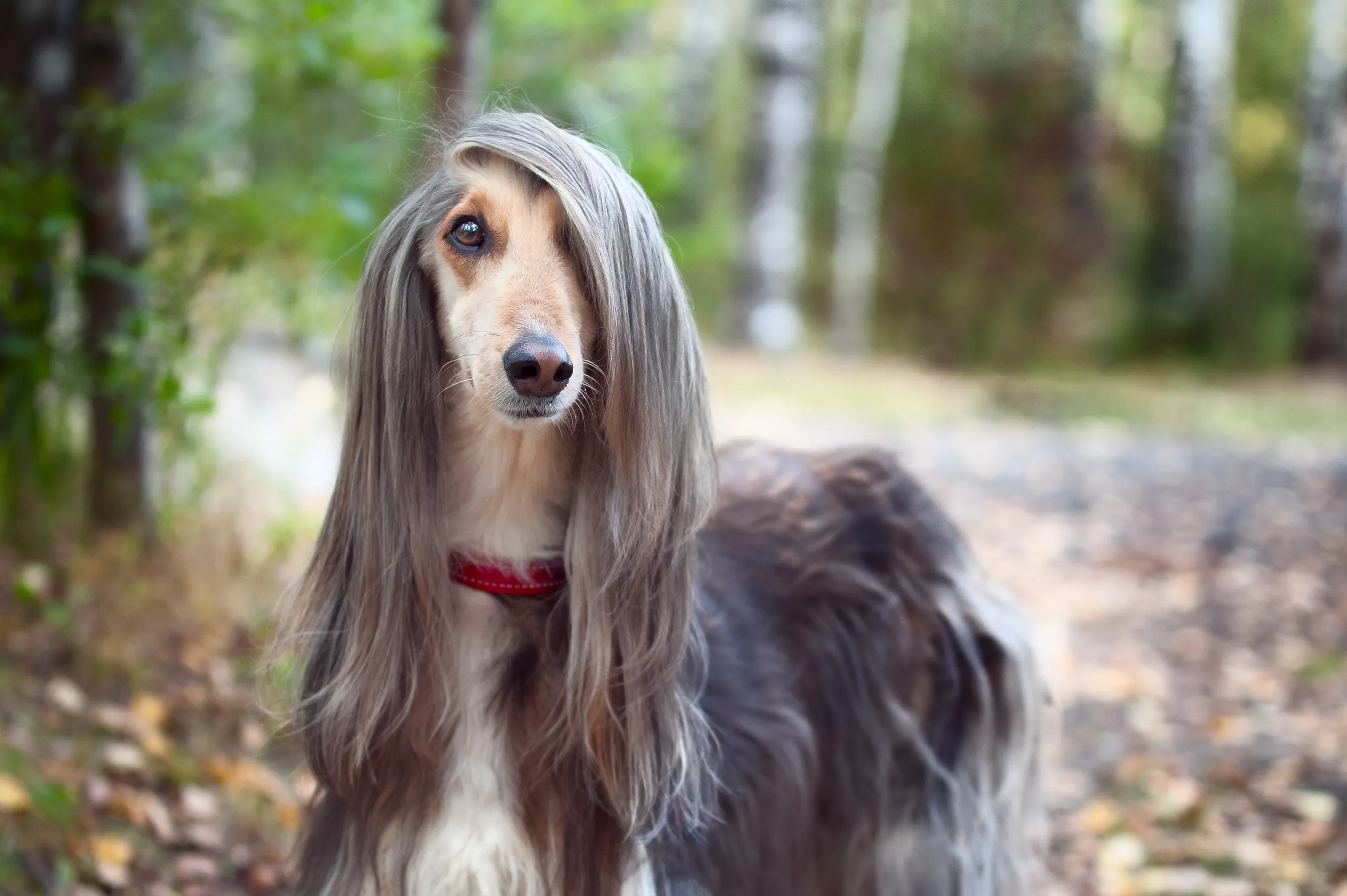 A regal gray and tan Afghan Hound with its distinctive long, flowing coat and elegant posture, looking at the camera.
A regal gray and tan Afghan Hound with its distinctive long, flowing coat and elegant posture, looking at the camera.
Afghan Hounds are striking dogs, famous for their long, flowing coats and slender, athletic builds. While their dramatic coats are high maintenance, they do not shed heavily, making them a consideration for some allergy sufferers. Built for speed, these elegant pups are loving toward their families but can be aloof with strangers, making early and consistent socialization vital for this noble breed.
27. Barbet
 A close-up of a curly red Barbet dog's face, showcasing its shaggy, woolly coat and characteristic beard.
A close-up of a curly red Barbet dog's face, showcasing its shaggy, woolly coat and characteristic beard.
The Barbet, pronounced “bar-bay,” is a cheerful dog with a shaggy, woolly coat that sheds minimally. This protective, curly coat is a nod to their history as French water dogs, and they absolutely love to swim. Their name itself, derived from the French word “barbe” meaning beard, highlights their characteristically hairy chin. Regular brushing with a slicker or pin brush, two to three times a week, is essential to keep their coat in good condition, especially after water adventures.
28. Shih-Poo
 A close-up portrait of a tan and black Shih-Poo dog with soft, wavy fur and expressive eyes.
A close-up portrait of a tan and black Shih-Poo dog with soft, wavy fur and expressive eyes.
The Shih-Poo is a charming mixed breed resulting from a cross between a Shih Tzu and a Poodle (most often a Toy Poodle). This small, low-shedding pup adapts well to nearly any living situation, provided they receive about 30 minutes of exercise and a thorough brushing session each day. They are known for their affectionate and playful personalities, making them delightful companions.
29. Peruvian Inca Orchid
 A rare Peruvian Inca Orchid dog, hairless with smooth skin, standing gracefully in a natural setting.
A rare Peruvian Inca Orchid dog, hairless with smooth skin, standing gracefully in a natural setting.
One of the rarest breeds, the Peruvian Inca Orchid is considered a low-shedding dog due to its nearly hairless body. This ancient breed, the national dog of Peru, comes in small, medium, and large sizes. While generally healthy, their hairless skin requires protection from extreme weather. They are typically alert, loyal, and good family guardians.
30. Malshi
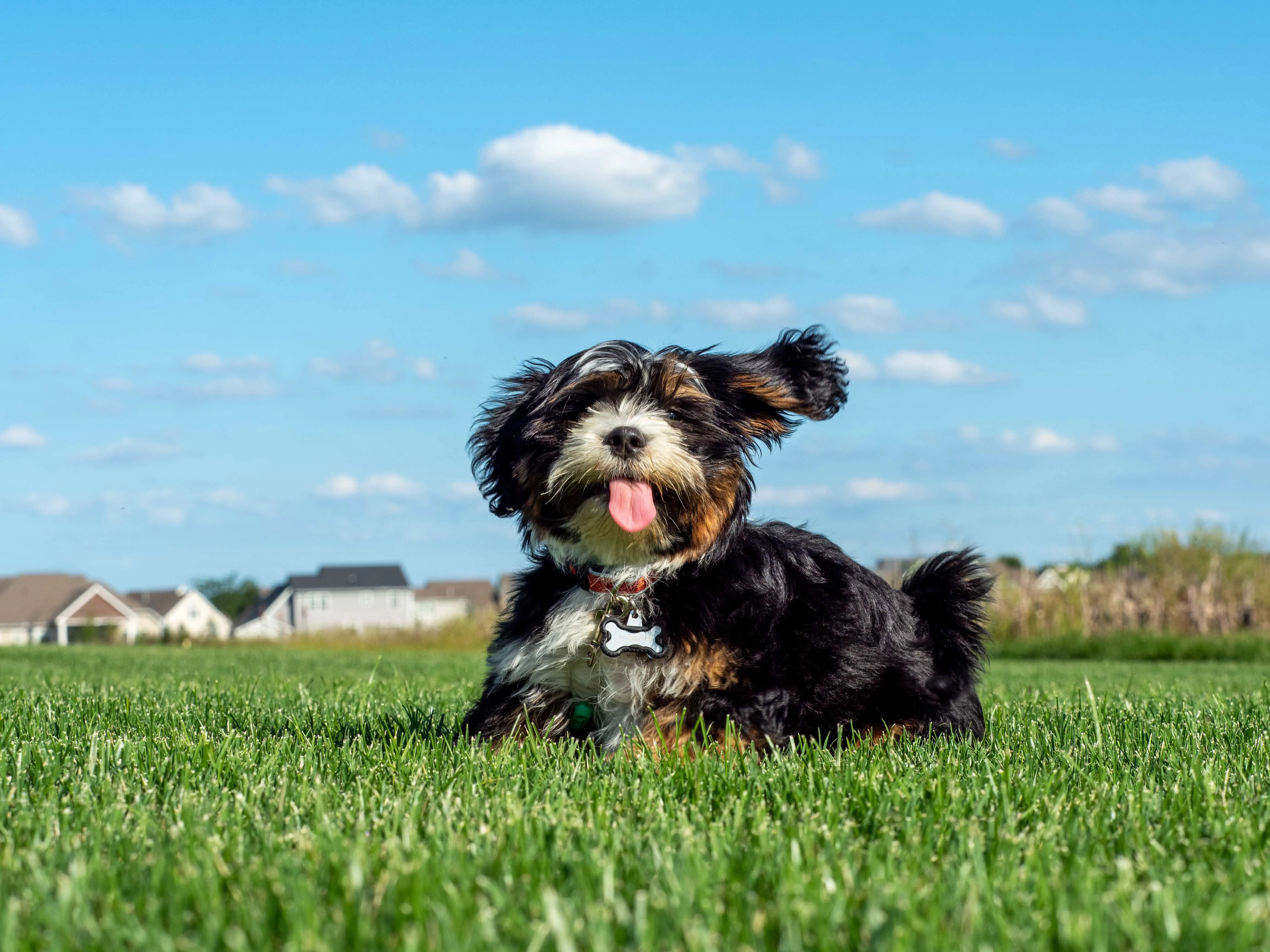 A tri-color Malshi dog, a fluffy mix of Maltese and Shih Tzu, sitting in vibrant green grass.
A tri-color Malshi dog, a fluffy mix of Maltese and Shih Tzu, sitting in vibrant green grass.
The Malshi is a joyful, small crossbreed of the Maltese and Shih Tzu, inheriting their low-shedding traits. These happy dogs thrive on close companionship and are most content when surrounded by their favorite humans. While they are friendly and playful, their fluffy coats require consistent grooming to prevent tangles and maintain their charming appearance.
Essential Tips for Living with a Low-Shedding Dog
Bringing home a dog breed that doesn’t shed much is a fantastic step towards a cleaner, less allergen-filled home, especially for those with sensitivities. However, successful cohabitation still requires proactive care and a few adjustments. These tips will help you create a comfortable environment for both you and your new companion.
Prioritize Regular Grooming
Even though these dogs shed minimally, their coats still require consistent attention. Regular grooming is paramount to managing dander and keeping their coats healthy.
- Brushing: Most low-shedding breeds benefit from daily or every-other-day brushing. This helps remove any loose hair, dander, and dirt before it spreads. The type of brush depends on the coat (e.g., slicker brush for curly coats, pin brush for longer coats).
- Bathing: Bathe your dog every four to six weeks, or as recommended by your vet or groomer. Using a gentle dog shampoo can help cleanse the skin and fur, further reducing dander. Some specialized shampoos are designed to help reduce pet dander for allergy sufferers.
- Professional Grooming: Many low-shedding breeds, especially those with continuously growing hair like Poodles or Bichons, require regular trims or hand-stripping by a professional groomer every 6-8 weeks. Budgeting for these visits or learning home grooming techniques is crucial for maintaining their coat health and managing shedding.
Maintain a Spotless Home Environment
Minimizing allergens in your home goes beyond just grooming your dog; it also involves diligent house cleaning.
- Vacuum Regularly: Use a vacuum cleaner with a HEPA filter to effectively trap pet dander from carpets, rugs, and upholstery.
- Dust Frequently: Dust surfaces with a damp cloth to capture allergens rather than just spreading them.
- Wash Bedding: Regularly wash pet beds, blankets, and your own bedding in hot water to eliminate dander and other allergens.
- Air Purifiers: Consider using high-efficiency particulate air (HEPA) purifiers in rooms where your dog spends the most time to filter out airborne allergens.
- Ventilation: Keep your home well-ventilated by opening windows when weather permits or using an air exchanger.
Consult Your Doctor for Allergy Management
While low-shedding dogs can significantly reduce allergen exposure, it’s always wise to consult your healthcare provider if you or a family member has dog allergies.
- Allergy Testing: Your doctor can confirm your allergies and discuss management strategies.
- Medication & Treatment: They may recommend antihistamines, nasal sprays, or allergy shots (immunotherapy) to help manage symptoms.
- Minimize Direct Contact: Try to avoid direct contact with your dog’s saliva or urine, as these also contain potent allergens. Washing hands after petting and avoiding letting your dog lick your face can make a difference.
- Designated Dog-Free Zones: Designate certain areas of your home, especially bedrooms, as dog-free zones to create allergen-reduced sanctuaries.
Conclusion
Choosing a dog breed that doesn’t shed much can open up a world of companionship for individuals and families impacted by pet allergies. While no dog is entirely allergen-free, these low-shedding breeds significantly reduce the amount of dander released into the environment, offering a viable path to pet ownership without constant allergic reactions. From the playful Bichon Frise to the stately Giant Schnauzer, the variety ensures there’s a perfect match for diverse preferences and lifestyles.
Remember that responsible pet ownership extends beyond choosing the right breed; it includes consistent grooming, maintaining a clean home, and proactive allergy management. By embracing these practices, you can enjoy the unconditional love and joy a canine companion brings, transforming a potentially challenging situation into a harmonious and fulfilling relationship. We encourage you to explore the wonderful world of low-shedding breeds and find the furry friend that completes your family.
References
- Zittritsch, Nicole, LVT, BSc, MPH. Content provided by PetMD.
